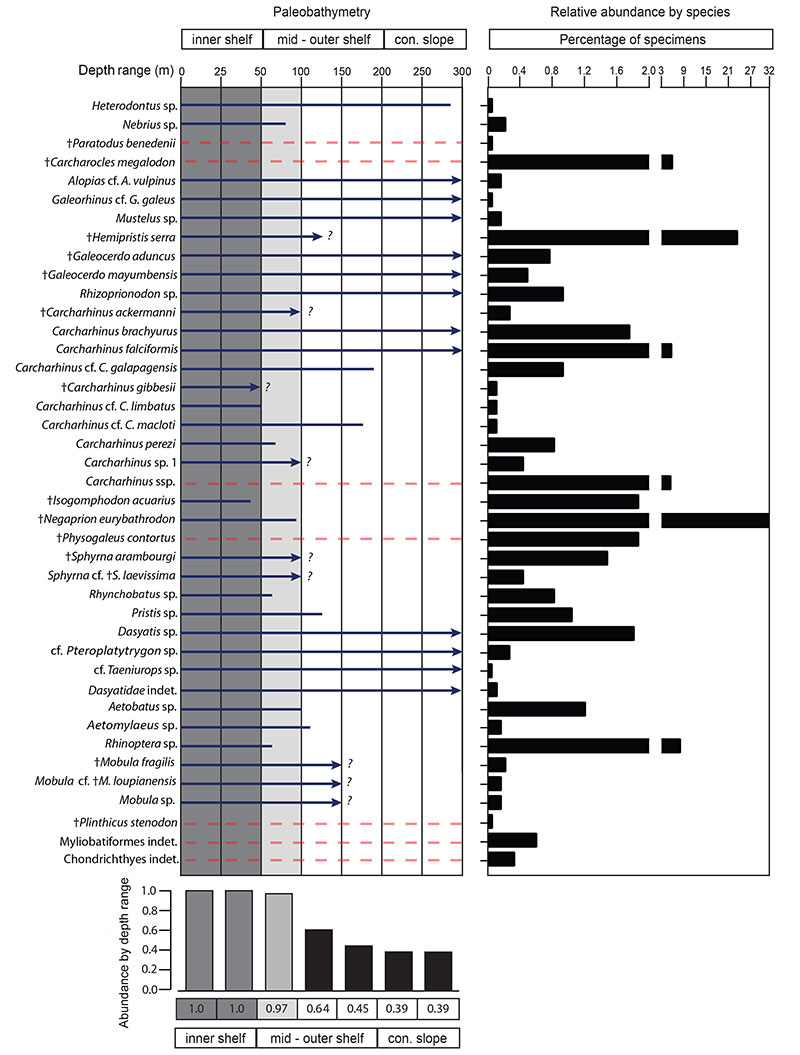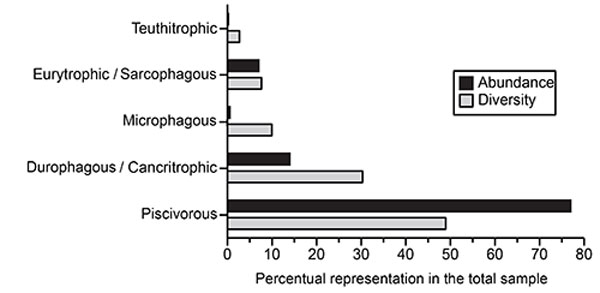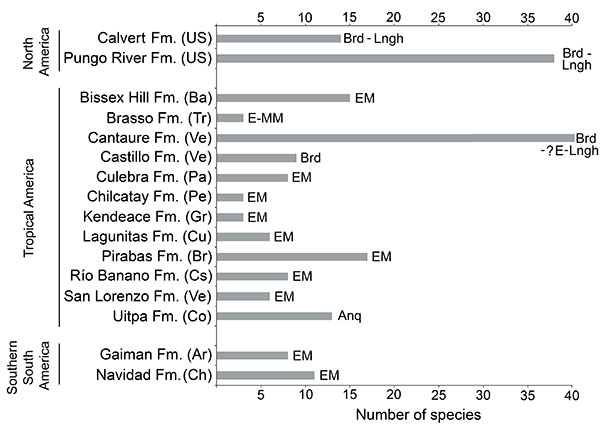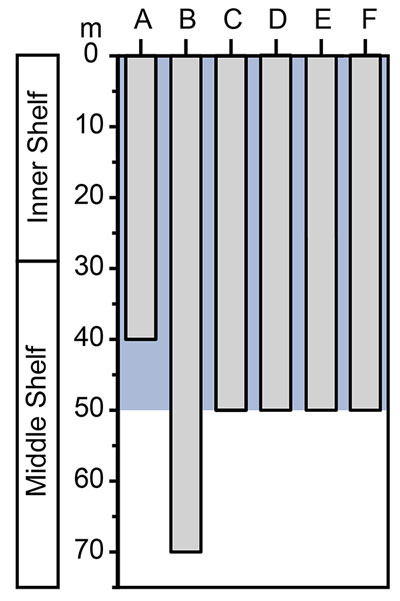FIGURE 1. Location and stratigraphy of the Cantaure Formation. 1. Fossiliferous localities. 2. Stratigraphic section of locality 1 (artesian well) and locality 2 (outcrop). Stratigraphic column modified after Aguilera (2010) and Aguilera et al. (2013).

FIGURE 2. Elasmobranch paleodiversity of the Cantaure Formation. 1. Orders and 2. Families and genera.

FIGURE 3. Orectolobiformes and Lamniformes of the Cantaure Formation. 1-9. Nebrius sp. (AMU-CURS-986); 10-11. † Paratodus benedenii (AMU-CURS-645). 12-21. † Carcharocles megalodon (12: AMU-CURS-997; 13: AMU-CURS-512; 14: UNEFM-PF-349; 15: AMU-CURS-996; 16: AMU-CURS-518; 17-18: UNEFM-PF-s/n; 19: AMU-CURS-512 and 20-21: AMU-CURS-515). 22-26. Alopias cf. A. vulpinus (22-23: AMU-CURS-985; 24-25: AMU-CURS-983 and 26: AMU-CURS-984). Jaw position: upper (10-11? 12, 14? 17, 22-25), lower (13, 15, 18) and indet. (1-9, 16, 19-21, 26). View: labial (1, 6, 10, 13, 20-21, 23, 24), lingual (2, 7, 11-12, 14-19, 22, 25-26), profile (3, 8), occlusal (4) and basal (5, 9).

FIGURE 4. Carcharhiniformes of the Cantaure Formation. 1-2. Galeorhinus cf. G. galeus (AMU-CURS-974). 3-7. Mustelus sp. (AMU-CURS-975). 8-13. † Hemipristis serra (8: AMU-CURS-731 and 9-13: AMU-CURS-644). 14-18. † Galeocerdo aduncus (14-15: AMU-CURS-730 and 16-18: AMU-CURS-647). 19-23. † Galeocerdo mayumbensis (19-20: AMU-CURS-995 and 21-23: AMU-CURS-646). Jaw position: upper (9-12), lower (8? 13) and indet. (1-7, 14-23). View: labial (1, 6, 7, 10, 15, 19, 21-22), lingual (2, 4, 8-9, 11-14, 16-18, 20, 23) and occlusal-lingual (3, 5).

FIGURE 5. Carcharhiniformes of the Cantaure Formation. 1-5. Rhizoprionodon sp. (1-3, 5: AMU-CURS-975 and 4: AMU-CURS-960). 6-10. † Carcharhinus ackermannii (6-7: AMU-CURS-713 and 8-10: AMU-CURS-714). 11-15. Carcharhinus brachyurus (AMU-CURS-990). 16-20. Carcharhinus falciformis (AMU-CURS-991). 21-25. Carcharhinus cf. C. galapagensis (AMU-CURS-973). Jaw position: upper (2, 4-14, 16-25) and lower (1, 3. 15). View: labial (6, 9, 12-13, 17-18, 20-21, 24) and lingual (1-5, 7-8, 10-11, 14-16, 19, 22-23, 25).

FIGURE 6. Carcharhiniformes of the Cantaure Formation. 1-4. †Carcharhinus gibbesii (AMU-CURS-958). 5-8. Carcharhinus cf. C. limbatus (AMU-CURS-944). 9-12. Carcharhinus cf. C. macloti (AMU-CURS-957). 13-17. Carcharhinus perezi (AMU-CURS-956). 18-22. Carcharhinus sp.1 (AMU-CURS-943). 23-24. Carcharhinus spp. (23: AMU-CURS-941 and 24: AMU-CURS-940). Jaw position: upper (1-24). View: labial (1, 4, 6-7, 10, 12, 14, 17-18, 20, 22-24) and lingual (2-3, 5, 8-9, 11, 13, 15-16, 19, 21).

FIGURE 7. Carcharhiniformes of the Cantaure Formation. 1-5. † Isogomphodon acuarius (1-2: AMU-CURS-950 and 3-5: AMU-CURS-951). 6-10. † Negaprion eurybathrodon (6-9: AMU-CURS-989 and 10: AMU-CURS-987). 11-15. † Physogaleus contortus (11-12: AMU-CURS-719 and 13-15: AMU-CURS-648). 16-20. Carcharhinidae indet. (AMU-CURS-939). 21-25. † Sphyrna arambourgi (21-24: AMU-CURS-961 and 25: AMU-CURS-962). Jaw position: upper (1-3, 6-9, 16-19? 21-22, 25), lower (4-5, 10, 20? 23-24) and indet. (11-15). View: labial (2, 6, 9, 11, 13, 17-18, 22, 24-25) and lingual (1, 3-5, 7-8, 10, 12, 14-16, 19-21, 23).

FIGURE 8. Carcharhiniformes and Rajiformes of the Cantaure Formation. 1-5. Sphyrna cf. † S. laevissima (1-3, 5: AMU-CURS-964 and 4: AMU-CURS-963). 6-11. Rhynchobatus sp. (6, 9: AMU-CURS-968; 7-8, 10: AMU-CURS-969 and 11: AMU-CURS-970). 12-20. Pristis sp. (rostral denticle 12-14: AMU-CURS-242; buccal teeth 15-20: AMU-CURS-967). Jaw position: upper (1-2) and indet. (3-11, 15-20). View: labial (1, 3), lingual (2, 4-5, 11), occlusal (6-8, 15, 17, 19), profile (18, 20), basal (9-10, 16), posterior (12) and dorsal (13-14).

FIGURE 9. Myliobatiformes of the Cantaure Formation. 1-10. Dasyatis sp. (1-2, 7-8: AMU-CURS-930; 3-4: AMU-CURS-932; 5-6: AMU-CURS-933 and 9-10: AMU-CURS-931). 11-17. cf. Pteroplatytrygon sp. (AMU-CURS-926). 18-21. cf. Taeniurops sp. (AMU-CURS-925). 22-27. Dasyatidae indet. (22-24: AMU-CURS-936 and 25-27: AMU-CURS-937). Jaw position: indet. (1-27). View: labial (4, 9, 11, 15, 21), lingual (2, 16), occlusal (1, 5, 13, 18, 22, 25), profile (3, 6-7, 10, 12, 17, 19, 24, 27) and basal (8, 14, 20, 23, 26).

FIGURE 10. Myliobatiformes of the Cantaure Formation. 1-3. Aetobatus sp. (1-3: AMU-CURS-716). 4-14. Aetomylaeus sp. (AMU-CURS-750). 15-29. Rhinoptera sp. (15-18: AMU-CURS-979; 19-21, 22-23, 24-25, 28-29: AMU-CURS-977 and 26-27: AMU-CURS-981). Jaw position: indet. (1-29). View: labial (11, 18), lingual (5, 12, 17, 21-22, 24, 28), occlusal (1, 4, 8, 10, 15, 19, 23, 26), profile (3, 13-14) and basal (2, 6, 7, 9, 16, 20, 25, 27, 29).

FIGURE 11. Mobulids of the Cantaure Formation. 1-11. † Mobula fragilis (1-3, 10-11: AMU-CURS-947; 4-6: AMU-CURS-948 and 7-9: AMU-CURS-949). 12-18. Mobula cf. † M. loupianensis (AMU-CURS-946). 19-23. Mobula sp. (AMU-CURS-927). 24-27. † Plinthicus stenodon (AMU-CURS-715). Jaw position: indet. (1-27). View: labial (1, 4, 7, 10, 14-15, 17, 22, 24), lingual (3, 6, 20, 26), occlusal (2, 5, 8, 16, 19, 25), profile (11-12, 18, 23, 27) and basal (9, 13, 21).

FIGURE 12. Myliobatiformes and other chondrichthyans of the Cantaure Formation. 1-6. Myliobatiformes indet. (AMU-CURS-507). 7-8. vertebra of chondrichthyan Indet. (AMU-CURS-928). 9-10. tooth of † Galeocerdo aduncus in association with barnacles of the family Balanidae (AMU-CURS-720). Jaw position: indet. (9). View: lingual (9), dorsal (1, 4, 5-6), ventral (2-3) and indet. (7-8).

FIGURE 13.Bathymetric ranges estimated for Cantaure Formation taxa and their relative abundance. Arrows indicate that the bathymetric range is greater; question mark symbol indicates uncertainty about the extent of the range. A dashed red line indicates that there is no information for the taxa. The gray shadow indicates the more probably depth range for this assemblage. In the relative abundance graphic the y-axis is shortened between 2 and 3 to improve the values visualization; note the greater abundance of shallow water taxa. The extinct species including P. benedenii, C. megalodon, P. contortus, and P. stenodon, and taxa without clear identification, including Carcharhinus spp., Carcharhinidae indet., Myliobatiformes indet. and Chondrichthyes indet., were removed from the analysis.

FIGURE 14. Dietary preference composition of the elasmobranchs from the Cantaure Formation. Percentages do not include Carcharhinus spp., Myliobatiformes indet. and Chondrichthyes indet.

FIGURE 15. Early Neogene chondrichthyan diversity in the Americas. Tropical America: Barbados (Ba), Brazil (Br), Colombia (Co), Costa Rica (Cs), Cuba (Cu), The Grenadines (Gr), Panamá (Pa), Perú (Pu), Trinidad (Tr) and Venezuela (Ve). North America: United States of America (US). Southern South America: Argentina (Ar) and Chile (Ch). Aquitanian (Anq), Burdigalian (Brd), Langhian (Lngh); early Miocene without differentiation (EM), early-Middle Miocene (E-MM). Formation(Fm.), early (E). Note: to references see “Paleodiversity significance” (see Discusion).

FIGURE 16. Paleobathymetric interpretation of the Cantaure Formation using several proxies. A, Foraminifera (Díaz de Gamero, 1974), B, corals (Griffiths et al., 2013), C, mollusks (Jung, 1965; Landau et al., in press), D, crustaceans (Aguilera et al., 2010), E, sharks (this study), F, teleosteans (Nolf and Aguilera, 1998, Aguilera and Rodrigues de Aguilera, 2001).


